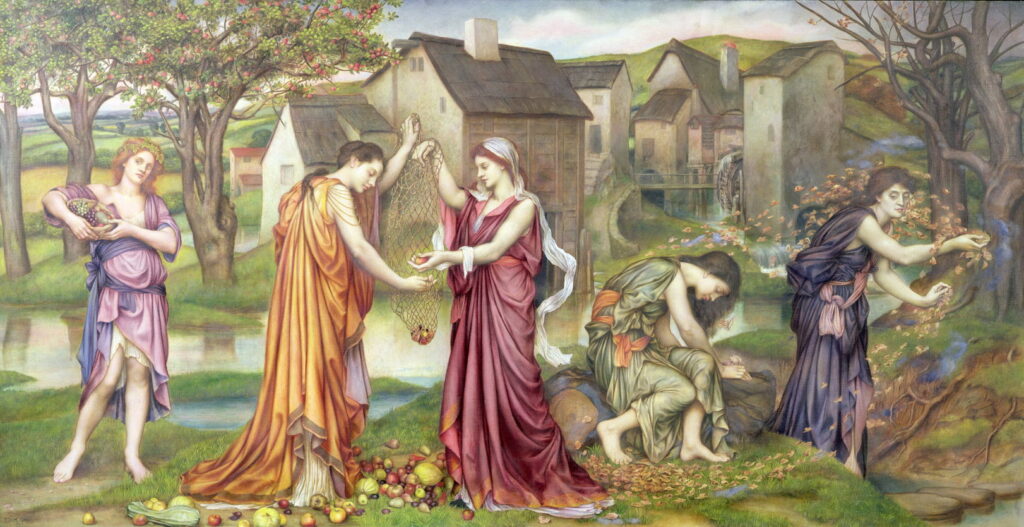Reading Visual Art: 206 Colour codes B

While the use of colour to encode meaning in terms of sex/gender or devils is relatively unusual, there are other situations where colour conventions are employed in paintings. Among these are standards seen in religious paintings, such as those of the Virgin Mary.
Sassoferrato (1609-1685), The Virgin in Prayer (1640-50), oil on canvas, 73 x 57.7 cm, The National Gallery (Bequeathed by Richard Simmons, 1846), London. Courtesy of and © The National Gallery, London.
In many paintings of the Virgin Mary, she’s shown wearing a cloak of ultramarine blue, although there are also examples of her wearing green, or a combination of red and green. In Sassoferrato’s The Virgin in Prayer, her cloak looks as if it was painted only yesterday rather than nearly four centuries ago. The choice of ultramarine may have originated from the fact that the pigment was weight-for-weight more expensive than gold, and visually even more stunning.
Dante Gabriel Rossetti (1828–1882), The Girlhood of Mary Virgin (1848–9), oil on canvas, 83.2 x 65.4 cm, The Tate Gallery (Bequeathed by Lady Jekyll 1937), London. © The Tate Gallery and Photographic Rights © Tate (2016), CC-BY-NC-ND 3.0 (Unported), http://www.tate.org.uk/art/artworks/rossetti-the-girlhood-of-mary-virgin-n04872
Dante Gabriel Rossetti’s painting of The Girlhood of Mary Virgin (1848–9) shows her embroidering with her mother Saint Anne, while her father Saint Joachim prunes a vine. Her red embroidery signifies the Passion to come, and the colour is often a symbol of Christ’s blood shed in the crucifixion. It was also adopted as the colour code for cardinals in the Roman Catholic church.
Raphael (1483–1520), Portrait of a Cardinal (1510-11), oil on panel, 79 x 61 cm, Museo Nacional del Prado, Madrid, Spain. Wikimedia Commons.
Raphael’s magnificent Portrait of a Cardinal from 1510-11 is notable not only for the lifelike modelling of flesh, but for his attention to the surface textures of the fabrics, something he had developed since his early days with Perugino. Three distinct fabrics are shown in the cardinal’s choir dress: the soft matte surface of the biretta (hat), the subtly patterned sheen of his mozzatta (cape), both in cardinal red, and the luxuriant folds of his white rochet (vestment).
With a limited range of colours available, it was inevitable that there were unfortunate conflicts, as red not only signifies the Passion and crucifixion, and cardinals, but the scarlet woman as a carnal red.
William Blake (1757–1827), The Whore of Babylon (1809), pen and black ink and watercolour on paper, 26.6 x 22.3 cm, The British Museum, London. Courtesy of and © Trustees of the British Museum.
There are two origins proposed for the term scarlet woman: the earlier is the New Testament book of Revelation, in its characterisation of the Whore of Babylon in chapter 17, verses 4-5, where she’s described as being dressed in purple and scarlet, and decked with gold, precious stones and pearls. William Blake’s watercolour of The Whore of Babylon from 1809 follows this literally, although his purple has faded now.
Carolus-Duran (1837–1917), Portrait of Mademoiselle de Lancey (1876), oil on canvas, 157 × 211 cm, Le Petit Palais, Paris. Wikimedia Commons.
Carolus-Duran’s Portrait of Mademoiselle de Lancey (1876) was exhibited at the Salon, and in its own way became infamous as ‘the lady with the red cushion’. Most of those who attended that Salon knew only too well that she was one of the great courtesans of the Belle Epoque, and could name many of her succession of rich lovers. The scarlets and crimsons and her direct wide-eyed gaze at the viewer left little to the imagination, and the critics were almost as merciless with Carolus-Duran as they had been in 1865 with Manet’s Olympia.
A few artists have used distinctive colour codes in other ways.
Félix Vallotton (1865–1925), Andromeda Standing with Perseus (1907), oil on canvas, 92 x 73 cm, Private collection. Wikimedia Commons.
Félix Vallotton’s Andromeda Standing with Perseus (1907) shows the sea monster Cetus heading for a defenceless Andromeda, as hero Perseus charges to her aid through a cleft in the black sky. Each figure is colour coded: green for the sea monster, pink for the near-victim, and blue for the hero, against a straw-coloured sea.
Evelyn De Morgan (1855–1919), The Cadence of Autumn (1905), oil on canvas, dimensions not known, The De Morgan Centre, Guildford, Surrey, England. Wikimedia Commons.
Evelyn De Morgan’s Cadence of Autumn from 1905 shows five women in a frieze, against a rustic background. From the left, one holds a basket of grapes and other fruit, two are putting marrows, apples, pears and other fruit into a large net bag, held between them. The fourth crouches down from a seated position, her hands grasping leaves, and the last is stood, letting the wind blow leaves out from each hand. They wear loose robes that are coloured (from the left) lilac, gold, brown, green, and black, the sequence seen in nature.
Colour can be at its most important in multiplex narrative, to indicate each occurrence of an actor, so helping the viewer assemble each part of the story into a whole.
Masaccio (1401–1428), The Tribute Money (1425-8), fresco, 247 x 597 cm, Brancacci Chapel, Florence. Wikimedia Commons.
Masaccio’s Tribute Money (1425-8) contains three images of Saint Peter, and two of the tax gatherer, each carefully set and coherently projected into the same single view. Although each is spaced apart from the next, no pictorial device is used to separate them into frames, and they form multiplex narrative. This refers to the Gospel of Matthew, in a story in which Christ directs Peter to find a coin in the mouth of a fish so that he can pay the temple tax. In the centre, the tax collector asks Christ for the temple tax. At the far left, as indicated by Christ and Peter’s arms, Peter (for the second time) takes the coin out of the mouth of a fish. At the right, Peter (a third time) pays the tax collector (shown a second time) his due.



